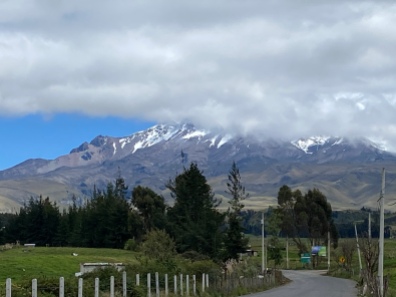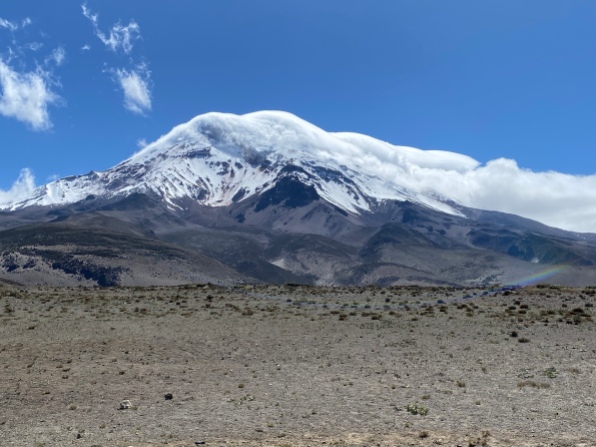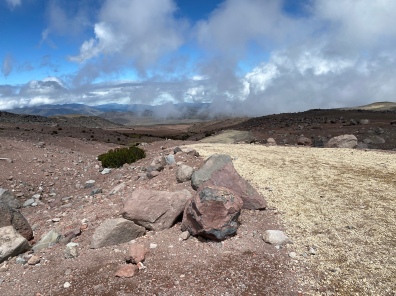Ingapirca to Riobamba
Saturday, August 6: We spent four hours cruising north at nosebleed heights around curvy mountain bends on the PanAmerican Highway, from Ingapirca to Riobamba. The patchwork farmland and homesteads dotting the majestic Andes were serene yet dramatic.

Driving along the PanAmerican Highway to Riobamba
We got our first glimpse of Volcán Chimborazo as we approached Riobamba.
Riobamba
We checked into Casa 1881, where we met the friendly Santiago. He gave us the lay of the land on a photocopied map of the town, marking sites to see in purple Xs and circles, and we went out promptly to explore.
We stopped at an encebollados stand, where we ate the famous soup of fish, potatoes, and corn while chatting in our pequito Spanish with the vendor, her daughter and her granddaughter.
The city has a strong indigenous presence displayed in the Saturday market, which we perused. The layout and architecture reflect the colonizing influences of the Spanish. Overall, though, the town had a derelict feel to it that was disappointing after having spent six days in lovely Cuenca.
In the afternoon, we happened upon a city parade with costumed dancers stepping to Latin beats from different areas within the province of Chimborazo. We asked some fellow spectators what it was all about and they said it was a kind of city celebration. Santiago later rolled his eyes and said these celebrations happen all the time. Even as a local, he didn’t know what this one was for.
See the video at the end of this post for live scenes of the city celebration.
Much of the city seemed rather ramshackle. It was my least favorite of the trip so far, especially as the reason we came, for the bikeride down Chimborazo, didn’t seem like it was going to happen. Our guide Eddie, of Spirit Mountain Biking, sadly got COVID. At that point, he was still trying to find an alternate guide and we’d told him if he felt okay, we’d go with him and all wear masks.
We were able to spy the white-topped Chimborazo from the streets of the town.

view of Chimborazo from Riobamba streets
We had dinner at a Spanish tapas place called Amona. I enjoyed Gambas al Ajillo (Shrimp Scampi) and Mike had Tablita de Picados (Jamon serrano, chorizo, queso tilsi, aceitunas, y pan). The proprietor in the cozy little restaurant locked the front door after every patron entered. Desperate children pressed their faces to the glass front door and made feeding motions, hands to mouths. On the way home in the dark, beside the deserted train station, a young man approached and started tailing us, but we turned abruptly and crossed the street. We looked back and saw him putting on a mask. It was disturbing and I felt uneasy in that part of town after dark.
Steps: 11,659; miles 4.93.
Riobamba to Baños
Sunday, August 7: Santiago prepared us a fabulous breakfast at Casa 1881: waffles, scrambled eggs, fruit galore, coffee. Afterwards, we drove a long mountainous road to Baños. Originally our plan was to bikeride down Chimborazo on the Sunday after we arrived in Riobamba (equal to today), but once we cancelled in June because of the protests, we lost our spot with Spirit Biking. We scheduled with Eddie for Monday (tomorrow), but he tested positive for COVID and hadn’t yet been able to find another guide. Thus we had two days in Riobamba with all our plans awry.
Our plan was to bicycle down through tunnels and past waterfalls in Baños. Lonely Planet Ecuador describes Baños as a “mixed bag.” There are steep gorges, waterfalls, dense forests. The town itself has “drab architecture, and an overcrowded backpacker-ghetto feel.”
There were many activities one could do in Baños, according to the guidebook. “Puenting” (crudely translated as “bridging”) is swinging from a rope tethered to two bridges. That was most definitely not appealing. There are thermal baths and massages to be had and all kinds of sports such as mountain biking, hiking, rafting, ziplining and partying. The ziplining places didn’t look appealing due to the ramshackle nature of not only the operations but also the surroundings. We were supposed to do the most popular mountain biking ride, “Rutas de Cascadas” to Rioverde. It is described as a “dramatic descent past a series of waterfalls on the road to Puyo, a jungle town 61km to the east.”
When we arrived in the town, we weren’t at all impressed. We just weren’t feeling the biking here. We drove down the “ruta” through five or six long dripping rudimentary tunnels and we barely saw any waterfalls. We felt relieved once we decided not to bother renting bikes.
Sometimes travel days are simply disappointing and there is nothing to do but take them in stride. Though the drive to Baños was a stunning one, everything about the area and the town itself seemed shabby and derelict. Though I do my best to find the positive in every place, I didn’t see anything enticing in this town.
The strange thing was that numerous people had asked us if we were going to Baños. “It will be so crowded on Sunday!” and “It’s a great place for ziplining!” and “You’ll love Baños, it’s beautiful!” I didn’t understand the enthusiasm.
The only saving grace was the roadside El Rancho Restaurant, where we enjoyed some coffee, fruit juice and tortillas de maíz.
Back to Riobamba
When we finally got back to Riobamba around 3:00, the town was dead because it was a Sunday. We sought out an ice cream spot Santiago recommended, Helados de Paila, and then wandered aimlessly taking pictures of each other wearing our Panama hats. Mike posed in front of a cool mural where a woman had her breast exposed and a cup of milk (breast milk?) that a hummingbird was drinking from. I posed in front of a mural with a rearing horse and the town of Riobamba with Chimborazo in the background.
We stopped at Parque la Libertad, built in 1920. It commemorated the 100th anniversary of the city’s independence.
The main church is La Catedral, on Plaza Mayor, built after the earthquake in 1797. The earthquake obliterated the city, which was later rebuilt about 14km from its original location. Parts of the modern cathedral are built using stones from the former city that was destroyed in that earthquake. The exterior mixed indigenous symbols with traditional Catholic elements in an effort to sway the indigenous population toward Catholicism. Inside the church was very modern and preparations for a concert were underway.

La Catedral
We found ourselves at one point under a street with umbrellas hanging overhead and a little pool of water in half a tomato (or apple?). Wandering further, we found a sushi restaurant across from Amona, the tapas place where we ate last night. We got sushi to go and ate it at the dining room table in Casa 1881. Santiago was surprised, “Is that sushi? Where did you get that? I didn’t know we had a sushi place here.” I started to think we had experienced more of the city than he had!
We cuddled up under blankets for an early night, not knowing until Eddie texted us late that night that we wouldn’t have to get up at the crack of dawn for our bikeride down Chimborazo. He was feeling too sick and couldn’t find an alternate guide. We were both disappointed and relieved. We were told the weather was often frigid and rainy atop the volcano, so we had been nervous about that. In addition, I had trouble breathing at the higher altitudes, and Chimborazo was the highest in Ecuador. Instead, we would drive to the volcano on our way to Latacunga on Monday.
Steps: 8,640; Miles 3.66.
Riobamba to Volcán Chimborazo
Monday, August 8: We left Riobamba at around 9:15 after meeting Eddie from Spirit Mountain Biking. He came by to meet us since he felt bad he’d had to cancel our ride due to COVID. We all stood outside and talked with our masks on and he brought us a Spirit Mountain Biking buff.
We drove to Volcán Chimborazo and were bowled over all the way. The day was sunny and blue, relatively warm and breezy. We stopped numerous times to take pictures of the volcano from every angle.
The indigenous people in the area call Volcán Chimborazo “Taita” (Father). It is 6,310m (20,702 feet) tall and is Ecuador’s tallest mountain, a strapping giant topped by a massive glacier. Not only is the extinct Volcán Chimborazo the highest mountain in Ecuador, but its peak, due to the earth’s equatorial bulge, is also the furthest terrestrial point from the center of the earth, according to Lonely Planet Ecuador.
The volcano sits near a smaller volcano, Volcán Cariuairazo (5020m), within the Reserva de Producción Faunistica Chimborazo. It is called a ‘fauna-production reserve’ because it is home to hundreds of vicuña, a wild relative of the llama. Once hunted to extinction, they were imported from Chile and Bolivia in the 1950s.
We caught the elegant silhouettes of the vicuña as they grazed in the foreground of the great volcano.
We were mesmerized watching what seemed like a living breathing being. The clouds were like a thick fleece blanket caressing the peak in a sensual way. It was captivating to watch, this symbiotic relationship between cloud and mountain. We stopped several times, in awe of it all. (You can see the living and breathing volcano in the video at the end of this post).
Though we were supposed to bike down the volcano, we wondered if we were better served by driving after all. We were able to stop many times to take pictures, which we may not have been able to do on a bike. It was disappointing to miss the adventure, but it was amazing to see the volcano by car as well.
We drove up to the access point for the Refugio Hermanos Carrel at 4,800 meters. Mike walked up a bit to the cemetery with gravestones marking people in recent years who have died trying to climb Chimborazo. Many monuments were scattered about in that barren landscape. One climber who died was Santiago Fabian Naveda Gonzalez: B. 6/25/1983 D. 12/22/2021.
We continued around the western side of Chimborazo on our way to Latacunga. This side is called the arenal (arena means ‘sand’) and it is very arid.
Volcán Chimborazo to Latacunga
Before driving through Ambato, we stopped at a restaurant to grab some lunch. We were hungry because it was almost 2:00. I tried to ask the waitress about the menu in Spanish and she started laughing so hard she scampered away and sent her mother over to take our order. Apparently our Spanish speaking made us a laughingstock! I ordered a shrimp dish (shrimp in a garlic sauce served in a lettuce bowl) with rice and a tomato/red onion garnish. The mother misunderstood our order and brought two of the same dish, one for me and one for Mike, even though Mike had ordered a cheese “sandwich” only to find what he imagined would be grilled cheese was just a slice of cheese stuck inside a bun. We took away Mike’s cheese bun but were stuffed from eating the two large shrimp meals.
We had a long drive then on a confusing and convoluted route right through the center of Ambato. It took us forever to get out of that maze of heavily trafficked roads. When we finally arrived on the north side of that chaotic city, the drive became calmer again. We made it to Latacunga and settled into our cute hotel, Hostal Huasicama.
Steps: 4,912; Miles 2.07.
Here is a video showing the street celebration in Riobamba and some live views of Chimborazo.
The next day we planned to drive to Quilatoa.






































































Overall was the trip a success, Cathy, and did you see all that you wanted to see? The volcano is spectacular.
LikeLike
I have such a fondness in my heart now for Ecuador after that trip, Jo. The nature, the culture, the people, the landscape – all appealed to me. Besides that, it opened my mind more to the possibility of travel in South America. I think I’ve always been a little afraid of it. I’m glad I’ve finally broken the ice.
For sure, the volcano was spectacular. Another was yet to come; we were amazed by that one as well. Plus the crater lake of Quilatoa, but that is another story. 🙂
LikeLiked by 1 person
It sounds like it was more comfortable in the car than on a bike. Gorgeous scenery.
LikeLike
It was certainly more comfortable, Carol, but I was looking forward to the adventure of riding the bike. The weather is often rainy and icy cold around the volcano, so we missed out on biking on a gorgeous sunny day (and not too cold until we got near the refugio). It was truly spectacular. 🙂
LikeLike